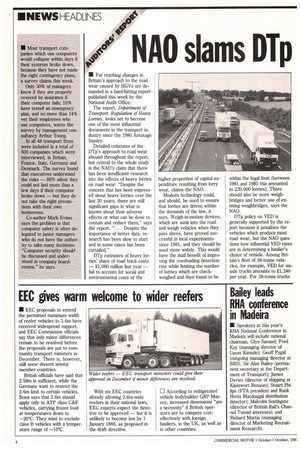/ N AO slams DTp on road wear
Page 6

Page 7

If you've noticed an error in this article please click here to report it so we can fix it.
• Far reaching changes in Britain's approach to the road wear caused by HGVs are demanded in a hard-hitting report published this week by the National Audit Office.
The report, Department of Transport: Regulation of Heavy Lorries, looks set to become one of the most influential documents in the transport industry since the 1980 Armitage Inquiry.
Detailed criticisms of the DTp's approach to road wear abound throughout the report, but central to the whole study is the NAO's claim that there has been insufficient research into the effects of heavy lorries on road wear: "Despite the concern that has been expressed about heavy lorries over the last 20 years, there are still significant gaps in what is known about their adverse effects or what can be done to contain and reduce them," says the report. ". . Despite the importance of better data, research has been slow to start and in some cases has been curtailed."
DTp estimates of heavy lorries' share of road track costs — 21,060 million last year — fail to account for social and environmental costs or the higher proportion of capital expenditure resulting from lorry wear, claims the NAO.
Modern technology could, and should, be used to ensure that lorries are driven within the demands of the law, it says. Weigh-in-motion devices, which are sunk into the road and weigh vehicles when they pass above, have proved successful in local experiments since 1981, and they should be used more widely. This would have the dual benefit of impro ving the overloading detection rate while limiting the number of lorries which are checkweighed and then found to be within the legal limit (between 1981 and 1985 this amounted to 220,000 lorries). There should also be more weighbridges and better use of existing weighbridges, says the NAO.
DTp policy on VED is generally supported by the report because it penalises the vehicles which produce most road wear, but the NAO questions how influential VED rates are in determining a haulier's choice of vehicle. Among Britain's fleet of 38-tonne vehicles, for example, VED for sixaxle trucks amounts to £1,240 per year. For 38-tonne trucks
with a 2+3 axle configuration, VED is to £3,100 per year, because the vehicle is estimated to cause 70% more road wear. Yet despite these different VED rates, more than two-thirds of 38-tonne trucks are currently running with the 2+3 configuration.
NAO also suggests that VED could be used to encourage the fitting of modern suspension systems to minimise road wear: "Of the 2600 million spent annually on structural road maintenance," it says, "the DTp accepts that savings of the order of £100 million per annum might be achieved by developing and fitting much improved suspension systems on all heavy lorries."
It calls for research to identify "which of the air suspension systems currently available is best and whether any other types, such as rubber or hydraulic systems, would be better." NAO says that more than 80% of lorries are currently equipped with steelsprung suspension systems, which TRRL research indicates cause up to 20% more road wear than equivalent air suspension systems.
One way of encouraging the fitting of effective suspension might be to allow vehicles or axles equipped with such systems to carry more weight than is currently permitted, says the report. NAO notes that this approach has been adopted in Belgium, which allows a 40-tonne GCW for airsuspended trucks: "Moving to the higher EEC limits would benefit road hauliers by about £70 million a year," says the NAO, "but against this must be set the cost of increased road wear (between £5 and £10 million a year) and the extra capital costs of bridge strengthening (£70 million)."
Other points included in the re-aort include:
Criticism of the dislocated and uneven enforcement of weight limits around Britain; O Discussion as to whether the average overloading fine of £129 is a sufficient deterrent; • Possible use of a system which detects unauthorised lorries in ban areas and signals their presence to police.
O Criticism of the DTp's approach to road planning, including its method of estimating whole-life costs and vehicle damage factors;
EI Examination of the £130 VED charged against lorries which carry abnormal indivisible loads (the DTp is expected to make an announcement on this next year).
The RHA has welcomed the NAO report and agrees that "there are many gaps in the available data on a number of important issues. . . further research should be undertaken to establish what are the genuine adverse effects of heavy lorries on roads."
On taxation, however, the RHA is critical of the NAO's claim that lorries should be taxed to cover unquantifiable social and environmental costs: "This tax overpayment is totally unjustified," it says.
The RHA agrees that there should be more weighbridges, but it is concerned by NAO suggestions that there should be more dynamic weighbridges and criticises the report for suggesting that the £70 million benefits of an increase in lorry weights to 40 tonnes would go direct to road hauliers. Following the last weight increase, says the RHA, the majority of benefits were passed on to customers.
Finally, on improved suspension systems, the RHA says that "more evidence of the advantage of improved suspension will be required before manufacturers and hauliers adopt any further changes."
The FTA has also welcomed the report, but remains cautious about the NAO's claims that air suspension systems would reduce road wear: "Nobody knows what is best. Air suspension is best for static weights, but we have no categoric evidence on dynamic weights," it says.












































































































